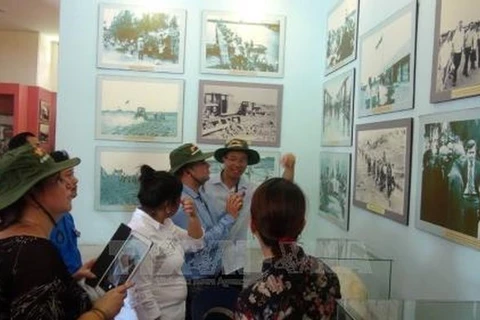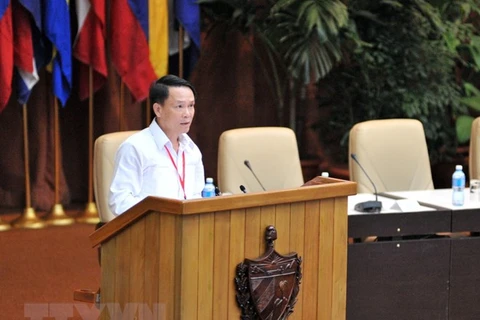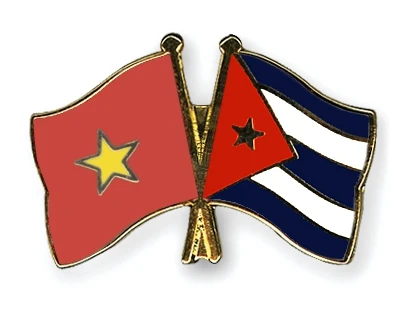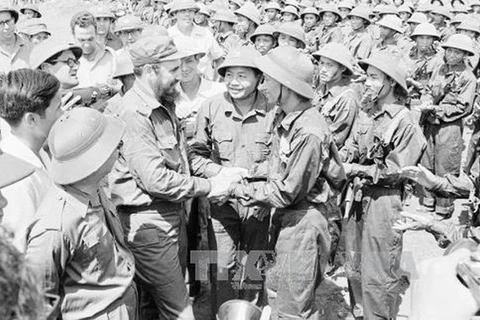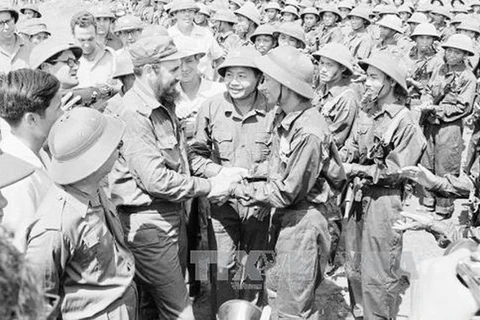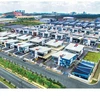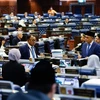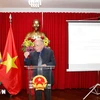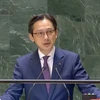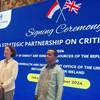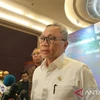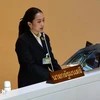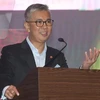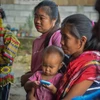 Ruvislei González Saez, head of Asia and Oceania Team of the Research Centre of International Policy of Cuba.
Ruvislei González Saez, head of Asia and Oceania Team of the Research Centre of International Policy of Cuba.Hanoi, (VNA) – On the occasion of the 45th anniversary of the historic visit by Fidel Castro Ruz to the liberated zone in South of Vietnam (September 12), Dr. Ruvislei González Saez, head of Asia and Oceania Team of the Research Centre of International Policy of Cuba, had an article on the trip.
On September 12, 1973, exactly 45 years ago, the Commander in Chief Fidel Castro Ruz arrived in Hanoi, Vietnam from, Algeria after having participated in the IV Summit Conference of the Movement of Non-Aligned Countries (MNOAL). Under an intense sun and a temperature of 31 degrees Celsius, Fidel descended at noon by the ladder of the plane IL-18 in the middle of a great expectation. The Vietnamese capital was partying very early. The visit had been shocked to every inhabitant of that sister nation.
Fidel was received by Le Duan, first secretary of the Workers' Party of Vietnam (today the Communist Party), Truong Chinh, president of the National Assembly, Pham Van Dong, prime minister, the legendary General Vo Nguyen Giap, Minister of Defense, Nguyen Duy Trinh and Le Thanh Nghi; all members of the Political Bureau of the Workers' Party. A warm and fraternal welcome accompanied by hugs and handshakes, expressing fraternity and affection between the peoples of Cuba and Vietnam. Several Vietnamese pioneers approached Fidel to give him flowers, while the leader of the Cuban Revolution bent down and kissed the cheek of one of the girls.
After the ceremony and having interacted with the Vietnamese people waiting for him at the airport, the Commander in Chief headed off in an open car, which was used for the first time in Vietnam in a reception for a Head of State or Government. He was accompanied by Le Duan, Truong Chinh and Pham Van Dong, while the rest of the Cuban delegation was behind in other black cars. As soon as he arrived at the protocol house, Fidel was received by the president, Ton Duc Thang, who wished him and the entire Cuban delegation a pleasant stay. The Cuban leader could not stop expressing his emotion for the feelings of affection that had been had so far with all Cubans, while it meant the example of the Asian nation with the following words:
"Vietnam is the most extraordinary example of the revolutionary spirit of a People. That is why we have traveled from Cuba, so geographically distant, but so close in ideas and feelings".
That same day, at six thirty in the afternoon, by the time of Hanoi had already darkened, Fidel went to the cemetery of Mai Dich to place a floral offering in homage to the fighters killed in the last two wars of resistance of the people Vietnamese against French colonialism and US imperialism. Each displacement of the Commander in Chief was a reason for the Vietnamese people to concentrate on the streets in order to greet them in their path. On his return from the cemetery he went to the Presidential Palace to attend a reception that in honour of the Cuban delegation offered the Workers' Party and the Government of the then Democratic Republic of Vietnam (now the Socialist Republic).
The next day (September 13, 1973), Fidel made a visit to the house where Ho Chi Minh lived, near to the Presidential Palace. Accompanied by the premier Pham Van Dong and General Giap toured the various parts and outdoor areas of the modest dwelling of Uncle Ho, preserved as a museum. Whoever walks by the place and has read about the Great Vietnamese Leader can realise his presence in the rosebush near his rooms and the simplicity of each one of the objects with which he lived in that place. In his transit through the place, Fidel received a direct explanation from the Vietnamese leaders about the activities of the eternal president of Vietnam. They showed him the room where he met with members of the Political Bureau and he used to receive his guests. Then they moved to the upper floor where the bedroom was and where they could see the chair placed next to a balcony, on which Ho Chi Minh sat to read.
Then the delegation moved to the room where Uncle Ho died in September 1969. It was built in the days when the American bombings were more intense on Hanoi. In it, is the map of Indochina in which Ho Chi Minh followed the course of the war. General Giap told Fidel that the map reflected the situation of the war on the eve of his death. It was also on the map Laos and Kampuchea (now Cambodia), then the Ho Chi Minh route was being built.
Fidel visited in the room of Ho Chi Minh, the bed where he died on September 2, 1969. At the end of the tour, the delegations of both nations began official talks at the Government Palace. On the night of that day, General Vo Nguyen Giap imposed the seal of Combatant of Dien Bien Phu on Fidel. The Cuban historical leader was visibly moved when General Giap told him that he wanted to give him the seal. The imposition was made at the end of a visit of more than an hour that Fidel made to the Museum of the Popular Army of Vietnam.
The Commander in Chief had the honour to receive the explanation of the strategy for the achievement of the victory of Dien Bien Phu of the architect himself, that is to say of Giap. When the Vietnamese General finished his exposition which was preceded in turn by a detailed explanation given by the first lieutenant Phan Ngoc Quynh, Fidel asked several questions. The Cuban leader did not lose a detail of the exhibition, according to those who were present. In the exchange of questions and answers the two great strategists (Giap and Fidel) got up from the seat, moved together and at the end they climbed into the same car. It was a unique moment, seeing at the same time two great men of the history of both peoples, only missing at that time Uncle Ho. Fidel lamented that he had not arrived in time to see the great Vietnamese president before 1969, but he could share with another heroic leader, Giap.
In his speech the Commander in Chief said:
Dear Vietnamese brothers:
Our two revolutions, The Vietnamese Revolution and The Cuban Revolution, one in Southeast Asia and the other in Latin America, constitute two events of historical importance and an enormous contribution to the cause of the international revolutionary movement.
(...) We arrived at this heroic land with a great admiration for the Vietnamese people, and we left with a greater admiration. We are stimulated by his victories and his extraordinary example. We are infinitely grateful for the hospitality and affection with which they have received us. And we only feel a pain, of not having arrived in Vietnam before September 3, 1969, and of not having had the privilege of meeting President Ho Chi Minh in life, which we admire so much; but it compensates us for having seen and have known the Vietnamese people closely, and to see reflected in him his work, his teachings, his education, his example, his heroism, his modesty.
President Ho Chi Minh was very aware of the moral values of the Vietnamese people and was always proud of his people. We, Cuban revolutionaries, like all the revolutionaries of the world, are also proud of the people”.
On the morning of September 14 at 11:15, Fidel arrived in Dong Hoi, the capital of Quang Binh province. In this city he was received by Dan Tat, permanent member of the Party Bureau of that province. From that place the Cuban leader left for the area of Vinh Linh, next to the parallel 17 in several jeeps and two buses. The route had to be done for approximately 50 km on complicated roads caused by the destruction of the war. Almost at dusk it was that the delegation reached Vinh Linh, an area where only tons of bombs were dropped. Those who were in that area say that you could see the craters of the projectiles thrown.
According to the prominent filmmaker and journalist Santiago Álvarez, on the morning of September 15, Fidel was crossing the Ben Hai River, which ran alongside the erroneous demarcation made from the 17th parallel, to move to the south of Vietnam. The leader of the Cuban Revolution was received on the other side of the river by leaders of the Provisional Revolutionary Government and fighters of the Liberation Forces of South Vietnam.
That moment was very special for Fidel. It had just materialized the beautiful dream of advancing through the places where war reached its most destructive levels, and where the expressions of heroism of the great Vietnamese people followed one another in the ten years before the visit. It was an extremely relevant event because he had been the first foreign Head of Government to visit the liberated area of South Vietnam.
In that historical moment he was accompanied by the director of the Latin American News, Santiago Álvarez, who would film a historical documentary entitled "The Four Bridges". Interesting idea based on the passage near Dong Ha where there were three bridges over the river Cam Lo. The first was built by the French, which represented colonialism and was destroyed; the second built by the Americans, which represented neocolonialism and was also destroyed.
Meanwhile, the third was a Vietnamese bridge through which the historic Cuban leader, modest but new. However, the fourth was called by Santiago as the bridge of solidarity, which was the reason for the title of the documentary.
When passing through Dong Ha, the village was almost destroyed. They continued along highway number one, then along highway number nine, very famous because the battle of Lam Son took place there, where the most prepared forces of the puppet regime of Saigon fled before the presence of the tanks of the liberation forces. Fidel visited the old Yankee military fortress on Hill 241, known to the Americans as the Carol base. An act was held and then the Cuban leader toured the main refuges of said base, formed by steel tubes and protected by earth heights.
Later on the stones and uniforms torn from the Yankee soldiers, in that historic hill Fidel balanced in his hands a flag of the Front of Liberation of South Vietnam. It seemed that he was the standard bearer of one of the combats of that region. Drenched in sweat, Fidel was very excited. And when it seemed that the emotion ended there, the Vietnamese revolutionaries gave him an M-48 tank, according to Santiago Álvarez himself.
Later he visited the Doc Mien base that was part of the electronic strategic complex that was called the MacNamara line where he greeted the revolutionary troops that were there.
An element that should not be forgotten in the story was when Fidel crossed Parallel 17 again, back to the north of Vietnam. On the way to Vinh Linh, the Cuban delegation found four workers injured by the explosion of a mine just before the caravan passed. Fidel, seeing the wounded young workers ordered to stop the vehicles. He got out and approached the injured peasants, while the Cuban doctors immediately paid attention to them. One of them was given serum, the perforations in the breasts and legs were visible from the explosion.
Back in Cuba on the plane, the Commander remembered the fact of the four Vietnamese peasants he found wounded in the path of Vinh Linh. Addressing one of the doctors asked him if the youngest had died, however the doctor replied that no, he was hurt but not death. He also asked if he had put blood plasma, but the doctor replied that only serum.
The historic visit was recorded in the history of Vietnam and Cuba. It was an important moment for the future of the brotherhood of both nations geographically distant, but close to feelings. The current 2018, is the 45th anniversary of such an event that is recorded in the minds of the Vietnamese and should be conceived as an intangible heritage of relations between Cuba and Vietnam. Few are the nations in the world that can feel like sisters in which the feelings of love, camaraderie and transparency are present for almost sixty years of uninterrupted relationships. This treasure must be conserved by the Parties, Governments and Peoples of Cuba and Vietnam.-VNA
